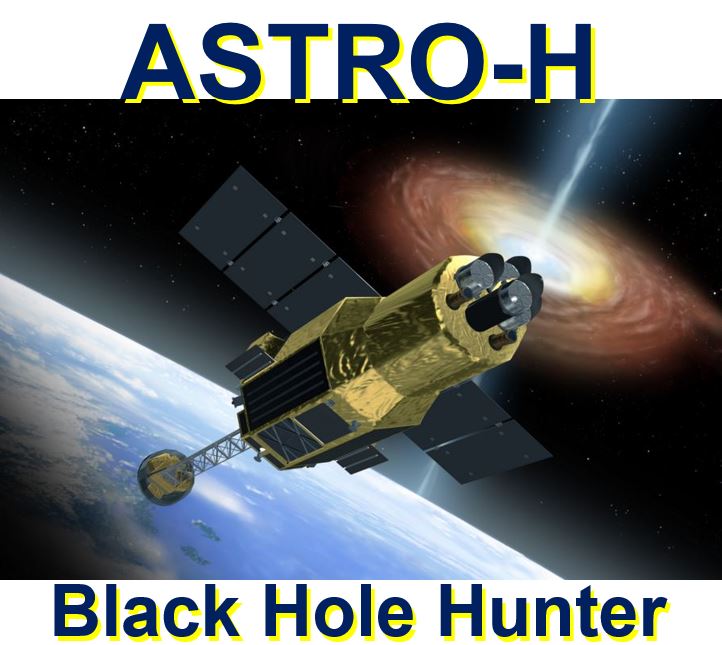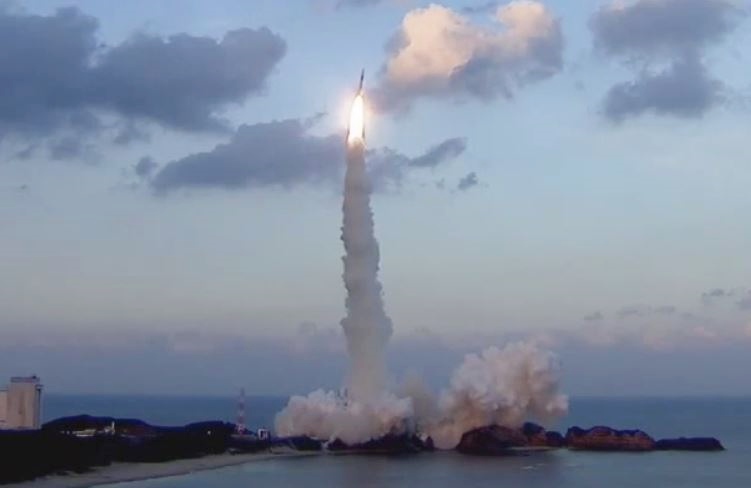Japan launched a satellite to study black holes, the genesis (origin) of galaxies and other cosmic mega-structures in deep space on Wednesday, the country’s space agency – JAXA – announced.
Called the ASTRO-H satellite, developed together with NASA and other aerospace groups in Europe and Canada, it will orbit at an altitude of approximately 360 miles and observe X-rays that come principally from galaxy clusters and black holes. ASTRO-H is Japan’s sixth satellite dedicated to X-ray astronomy.
The satellite carries a state-of-the-art instrument as well as two telescope mirrors built at NASA’s Goddard Space Flight Center in Greenbelt, Maryland, USA.
 According to JAXA: “”Hitomi” (ASTRO-H) enables high sensitivity observations of celestial sources across a wide energy range, from X-rays to gamma-rays, bands presenting considerable technical challenges.” (Image: JAXA)
According to JAXA: “”Hitomi” (ASTRO-H) enables high sensitivity observations of celestial sources across a wide energy range, from X-rays to gamma-rays, bands presenting considerable technical challenges.” (Image: JAXA)
ASTRO-H was transported into space by Japan’s mainstay H-IIA F30 rocket, which blasted off from the Tanegashima Space Center at 5:45 pm. Tanegashima is the easternmost of the Osumi Islands, just south of the major island of Kyushu.
According to JAXA (Japan Aerospace Exploration Agency -国立研究開発法人宇宙航空研究開発機構), the satellite separated from the H-IIA rocket with no difficulty.
JAXA confirmed that the satellite deployed its solar array paddles at 7:40 pm on 17th February.
Satellite nicknamed Hitomi – the ‘eye’
JAXA said in a statement regarding the satellite’s name:
“ASTRO-H is the eye to study the hot and energetic universe. Therefore we name ASTRO-H, ‘Hitomi’. The word Hitomi generally means ‘eye’, and specifically the pupil, or entrance window of the eye – the aperture!”
There is also an ancient Japanese legend that inspires the name Hitomi: Many years ago, an artist was painting four white dragons on a street. He finished his painting, but without ‘Hitomi’ (no eyes). Bystanders asked him why he had not painted Hitomi.
 This drawing shows the locations and energy ranges of the ASTRO-H science instruments and their associated telescopes. (Image: nasa.gov. Credit: JAXA/NASA’s Goddard Space Flight Center)
This drawing shows the locations and energy ranges of the ASTRO-H science instruments and their associated telescopes. (Image: nasa.gov. Credit: JAXA/NASA’s Goddard Space Flight Center)
The artist was reluctant to add eyes to the dragons, but the people kept insisting. So, he drew Hitomi on two of the four dragons, which immediately came to life and flew up into the sky. The two dragons without Hitomi stayed where they were.
Regarding the Hitomi legend, JAXA explained:
“The inspiration of this story is that Hitomi is regarded as the ‘One last, but most important part’, and so we wish ASTRO-H to be the essential mission to solve mysteries of the universe in X-rays.”
“Hitomi refers to the aperture of the eye, the part where incoming light is absorbed. From this, Hitomi reminds us of a black hole. We will observe Hitomi in the Universe using the Hitomi satellite!”
Packed with cutting edge equipment
According to NASA, Hitomi is expected to provide breakthroughs in a wide range of high-energy phenomena in the cosmos, including the superheated material on the verge of falling back into a black hole and the evolution of enormous galaxy clusters.
Robert Petre, chief of Goddard’s X-ray Astrophysics Laboratory and the U.S. project scientist for ASTRO-H, said:
“We see X-rays from sources throughout the universe, wherever the particles in matter reach sufficiently high energies.”
 The H-IIA F30 rocket with the “ASTRO-H” onboard launched at 5:45 p.m. on Feb 17, 2016 (JST) from the Tanegashima Space Center. (Image: nasa.gov)
The H-IIA F30 rocket with the “ASTRO-H” onboard launched at 5:45 p.m. on Feb 17, 2016 (JST) from the Tanegashima Space Center. (Image: nasa.gov)
“These energies arise in a variety of settings, including stellar explosions, extreme magnetic fields, or strong gravity, and X-rays let us probe aspects of these phenomena that are inaccessible by instruments observing at other wavelengths.”
ASTRO-H can observe X-ray sources, like neutron stars and galaxy clusters, more than ten times fainter than Suzaku (its predecessor), which operated from 2005 to 2015.
To do this, it is equipped with four co-aligned focusing X-ray telescopes and a suite of state-of-the-art instruments that provide simultaneous coverage across the satellite’s entire energy range.
JAXA Video – Introduction to ASTRO-H
